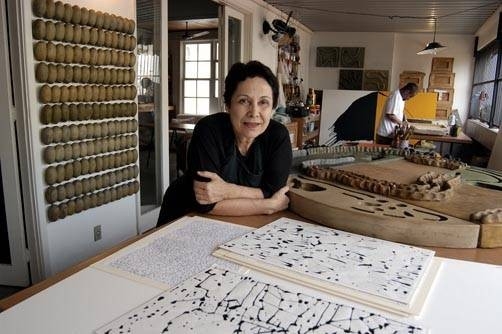 Biography
Biography
ANNA MARIA MAIOLINO
(1942)
Born in Scalea, Calabria,
Italy
One of the most important artists of her generation working in
Brazil, Maiolino has always sought to connect art and life—to
give structure to primordial experiences of language, self, and
the body. Her work breaks down the limits of objects and medium
and address issues of subjectivity and the idea that language is
constantly remaking itself. The ongoing, unfinished nature of
her practice flows out of a dialogue between opposite yet
complementary categories that dissolve the dichotomies of inner
and outer, self and other, void and matter, ancestral and
contemporary.
Maiolino’s drawings, paintings, sculptures, books, engravings,
films, videos, installations, and performances often emphasize
the immanence of the act over the concept of a permanent object.
Her early artistic experiments connect her to key moments of
Brazilian art history: the New Figuration movement, neo-Concretism,
and New Brazilian Objectivity. Later, she was associated with
the neo-Avant-garde in Europe (particularly in Italy) and
Minimalism and Conceptualism in the United States.
Born in Calabria, Italy, in 1942, Maiolino immigrated with her
family to South America in 1954, living first in Venezuela then
moving to Rio de Janeiro in 1960. The instability and
displacement inherent in her personal history has permeated the
methods of her art. Her work is linked to ideas of fertility and
physical and spiritual sustenance and draws upon narratives
related to the self, language, and labor as well as metaphors
from the feminine imagery in daily life. These narratives
connect endless chains of people, gestures, and processes. They
refer, through the actions of the body and its repeated
gestures, to the making and remaking of the self in the
encounter with others and the creation and experience of the art
object.
During the 1960s, Maiolino was part of the New Figuration
movement. In 1967, she took part in the exhibition New
Brazilian Objectivity, organized by Hιlio
Oiticica. Her works from these years, primarily prints and
paintings, are a form of resistance to the military regime in
Brazil as well as a reaction against the country’s growing urban
inequalities. They are also a meditation on the condition of
women within a patriarchal society. Some of these pieces evoke
the popular practice of string literature (literatura de
cordel), a woodblock printing tradition of Brazil’s
northeast that depicts poetic narrations of everyday themes of
life in the city.
In 1968, Maiolino moved to New York and shifted away from
representation toward Minimalism and Conceptualism. Returning to
Brazil during the early 1970s, she began to experiment with
drawing and objects made of paper, exploring spatial, corporeal,
and existential issues that connect her work to the neo-Concrete
practices of the period. Mental Maps (1971-74),
Constructed Projects (1972), Print Objects (1971-72),
Drawing Objects (1971-76), and her series Book Objects
(1971-76) are some of the works from these years. From the
mid-1970s through the 1980s she created installations, Super 8
films, paintings, drawings, washes, and projects that encouraged
a performative interaction between the audience and the art
object.
In 1989 Maiolino moved to Rio de Janeiro from Buenos Aires and
began to work with clay. Since then she has continued to explore
this basic material, relying on traditional labor-intensive
processes such as modeling, mold making, and casting. Maiolino
emphasizes the repetition of gesture as a fundamental unit of
artistic action through a series of installations involving
hand-produced sculpture-objects. Produced in succession, each of
these objects bears the mark of the artist’s hands. The clay
registers memories of actions and also alludes to the
emancipatory potential of the subject to remake him- or herself
in the experience of the object. These pieces resonate with the
spectators’ own experience, the repeated, often unconscious,
actions of their everyday labors. In Many (1991-1995),
for example, the artist’s gestures are multiplied in the intense
accumulation and production of small, simple forms–clay
fashioned into balls or cylinders–that, in being shaped and
reshaped, suggest the first utterance of language, functions of
the body, hands kneading dough, the unfolding of time and
memory, the self-renewing continuity of life.
About the Artist
Born in Italy and a Brazilian citizen since 1968, Anna Maria
Maiolino studied in The Escuela Nacional Cristobal Rojas
(Caracas), in the Escola Nacional de Belas Artes (Rio de
Janeiro) and in the International Pratt Graphics Center (New
York). She has participated in exhibitions such as Tropicαlia:
A Revolution in Brazilian Culture
at the Museum of Contemporary Art, Chicago (2005), Entre
Outros/Territories of Immanence: A Retrospective (2005) at
the Pinacoteca do Estado, Sγo
Paulo, The Object Scuptur (2002) at the Henry Moore
Institute, Virgin Territory: Women, Gender, and History in
Contemporary Brazilian Art (2001) at the National Museum of
Women in the Arts, Washington , D.C., Vida Afora/A Life Line
at the Drawing Center, New York (2001), N Vezes Um/N Times
One (2001), installation and projection of Super 8 films and
videos in the Art in General, New York, Beyond
Perceptions:The Sixties Experiment (2000) at the Independent
Curators International, New York, Re-Aligning Vision: Current
Alternatives in South American Drawing (1997) first held in
Museo del Barrio, New York, Inside the Visible (1995)
first held at the Kanaal Art Foundation in Kortrijk, Belgium and
at the ICA, Boston, and America - Bride of the Sun. 500 Years
of Latin America and the Low Countries (1992) at the Royal
Museum of Fine Arts in Antwerp, Belgium.
In 2002, Anna Maria Maiolino Vida Afora/A Life Line (The
Drawing Center’s Press) was published covering the artist’s 45
years of production.